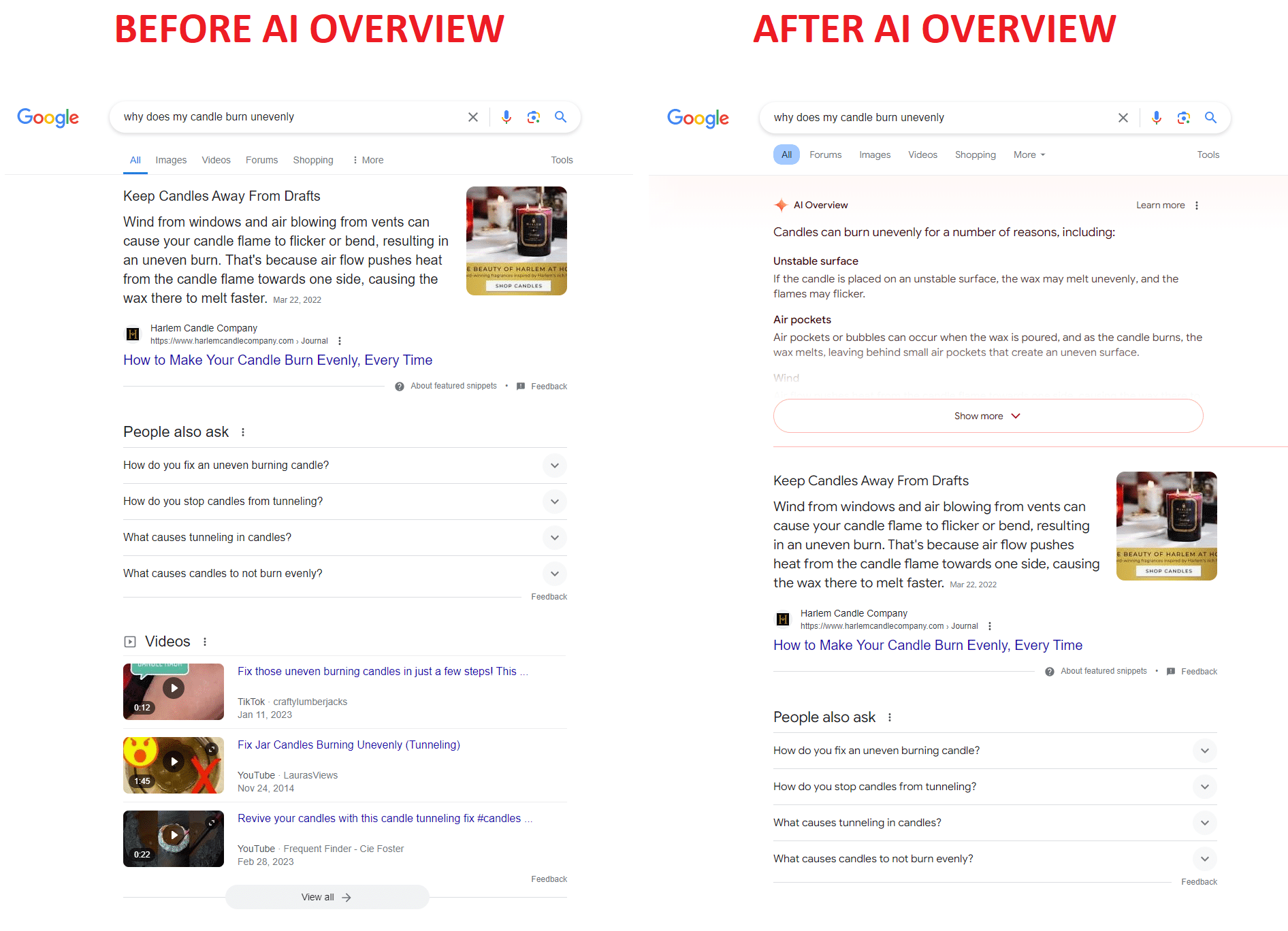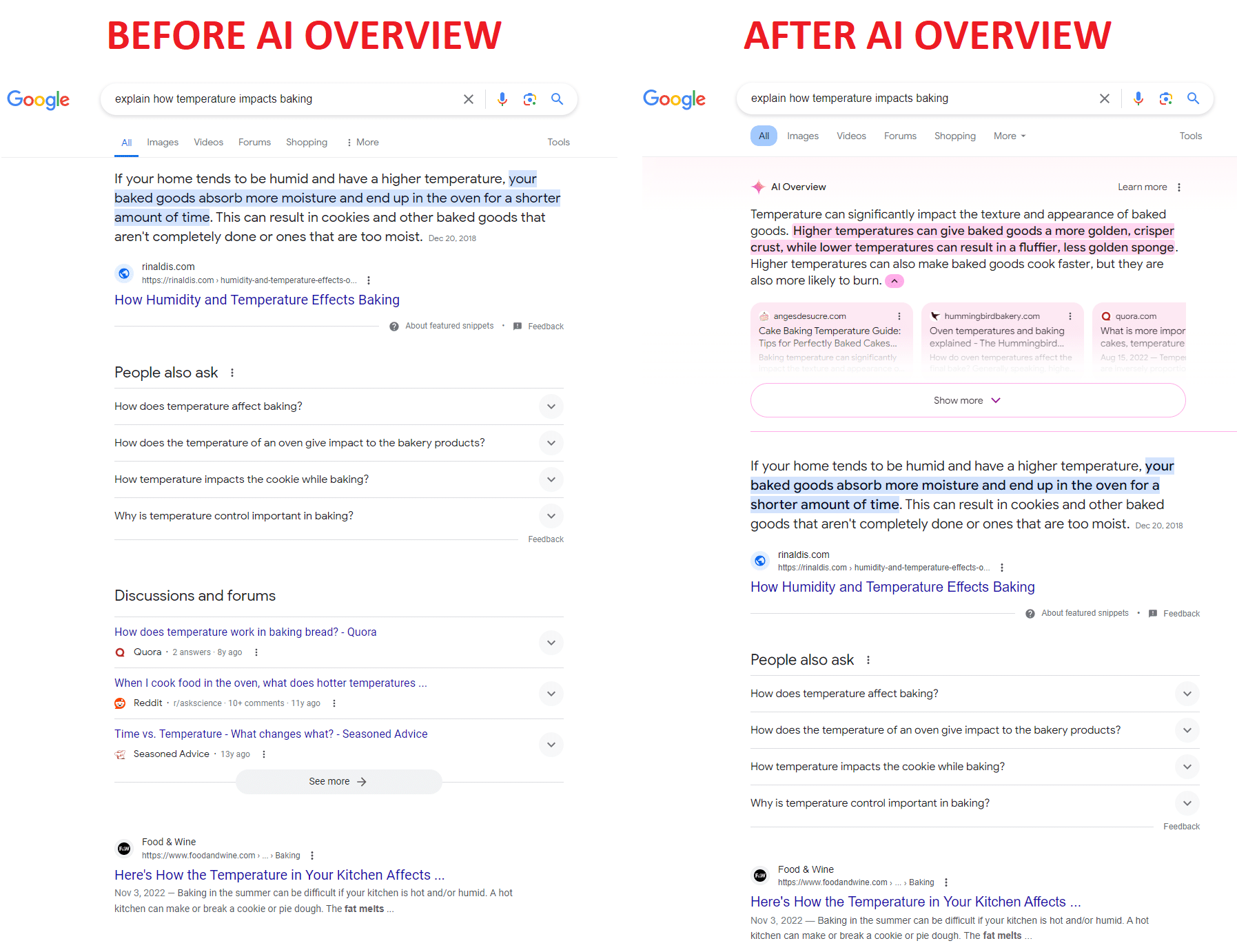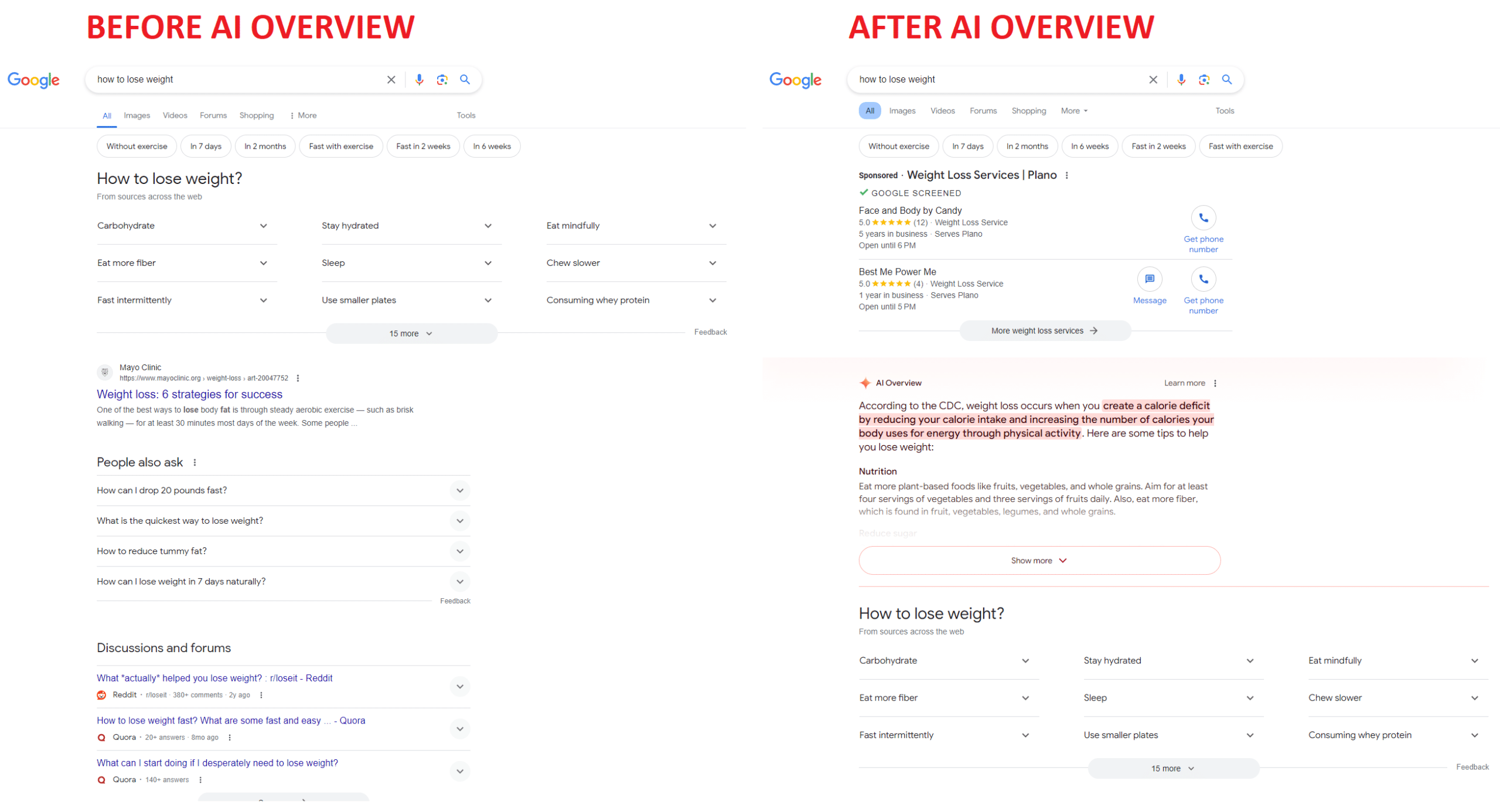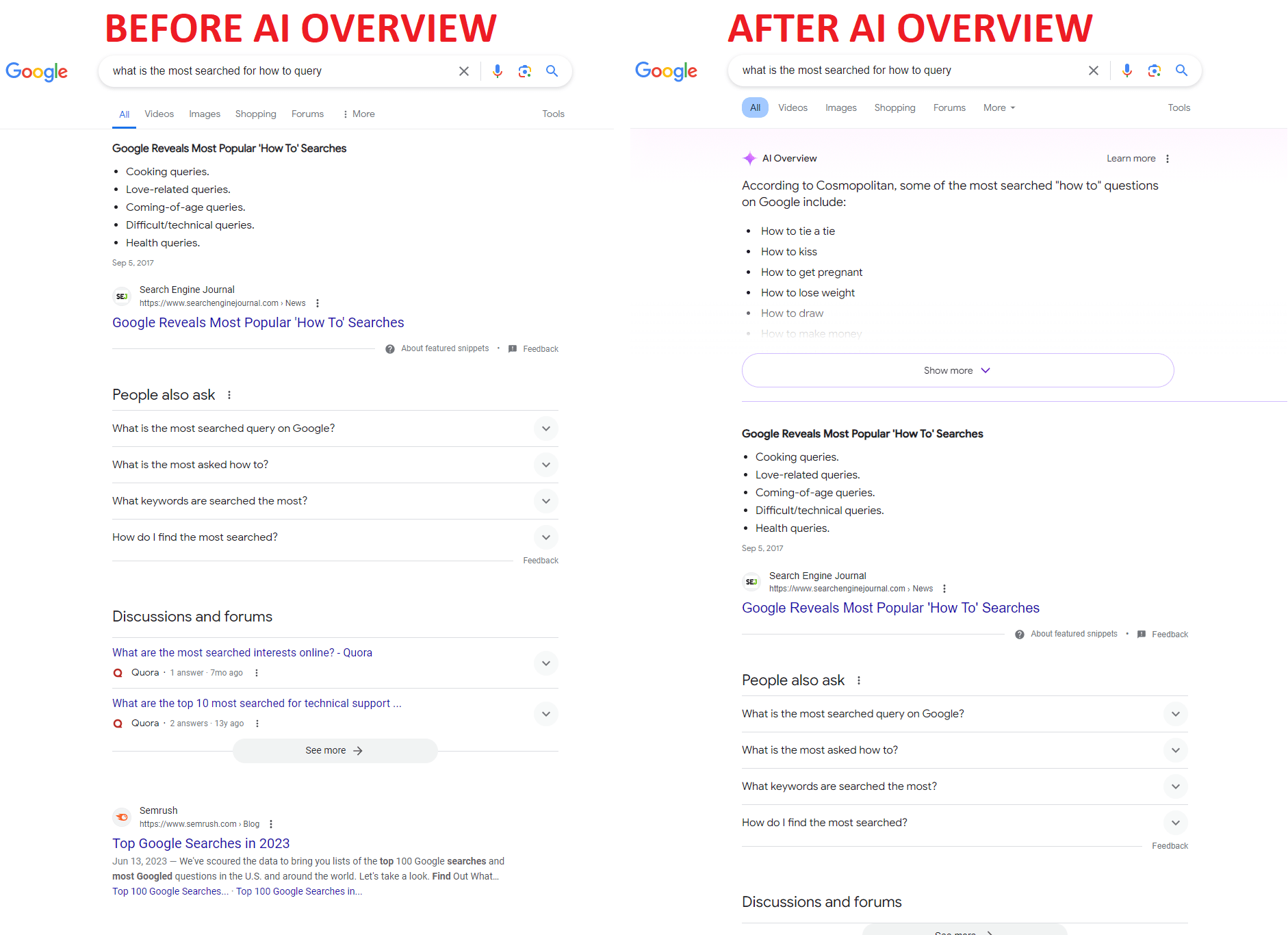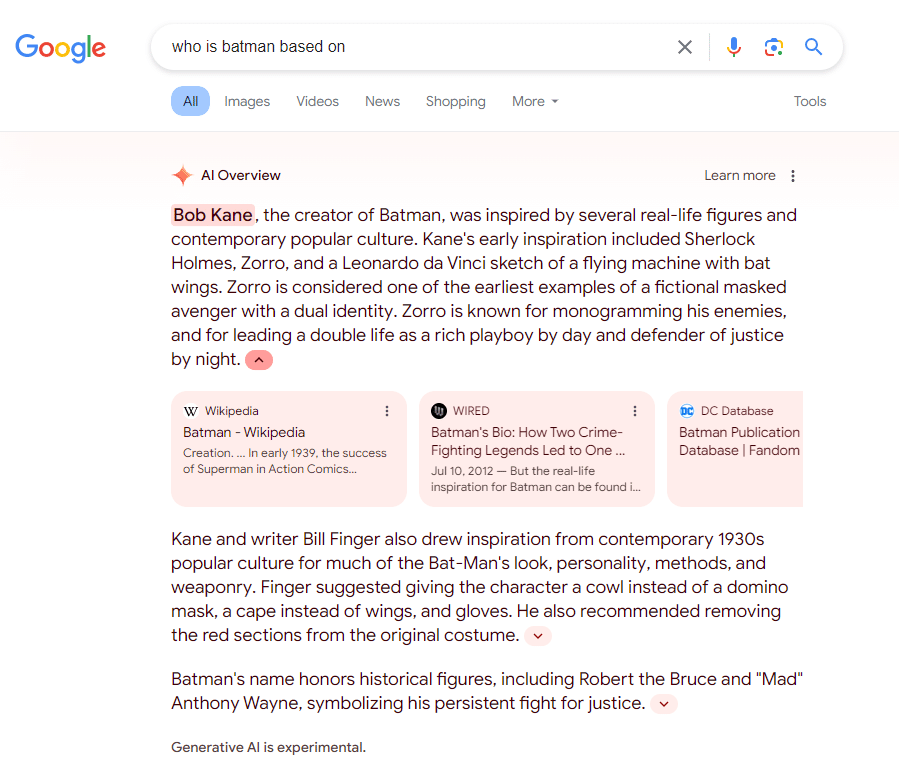If you thought the September 2023 Helpful Content Update or the March 2024 Spam + HCU + Core Updates were big, AI landing in the SERPs is likely the single biggest change to Google or Search ever.
This video probably sums up AI Overviews the best though, so consider it a useful summary vs. reading this entire article:
Googlers making "Helpful Content" https://t.co/Yf1zta8hav pic.twitter.com/VxayJV5QLf
— Amit Tiwari (@teamamittiwari) May 15, 2024
(note: this was sarcasm)
This article is about what was previously referred to as “Search Generative Experience” or SGE but that appears to be a name used by Google Labs only and instead their Google I/0 2024 announcement included 2 AI in the SERPs updates which are AI Overviews and AI Organized SERPs. I wax about some stuff from the past and the future in the prologue which you should skip if you’re just here for meat and potatoes of what the AI in the SERPs means and is doing – that means start with “What to Expect With AI Overviews” section.
Navigate This Article:
** Prologue **
A Little Background on My Predictive Capabilities
What Google Believes is About to Happen
The Blue LED Problems in AI
** SEO TOPICS **
What to Expect With AI Overviews
– Fact Sheet: What Google Says About AI Overviews
– Screenshots of SERPS Before and After AI Overviews Are Added
– Let’s Talk About Links in AI Overviews
– Is it Possible to Block My Content From Being in AI Overviews?
– How to Control Your Content Appearing in Google’s AI Overviews
– Government Scam Warning About SGE / AI Overviews
– Examples of AI Overviews Being Inaccurate
– Examples of AI Overviews Plagiarising or Completely Duplicating Existing Works
AI Organized Search Pages
– Impact of AI Organized Search Pages
What Happens if SEO Really Dies This Time?
How to Move Into A Future Without Google
Victory Lap
The past 2 days have been a bit of a victory lap for me as OpenAI and Google’s announcements have come out, a sense of accomplishment has washed over me – this is the future I have been planning for since roughly 2011. I have been predicting for over a decade the coming of a version of the web that is seamlessly integrated into everything. If you understand Moore’s Law, the Google founders obessesion with the Stark Trek Computer, incenitives for tech companies, hype cycles driven by journalism and consumers of journalism, along with consumer behavior trends then you probably also saw this coming, or as one colleague has repeatedly told me for a decade “you’re not special, I predicted this too”. I have made this prediction on stages on marketing conferences all of which have declined to invite me back citing how unhelpful my talks about the future were and even had a crowd confront a Google representative in 2017 (shortly after the invention of “Transformers” at Google) about the possiblity of a web without websites to which he acknowledged it was one of many possibilities. My predictions have been conveyed to my clients over this time along with strategies and tactics to thrive if and when this future arrived. To say that I have studied this moment in history for some time and in as much detail as one can study something that doesn’t yet exist would be an understatement.
This article is an in-depth look at what I’ve called Task Completion Engines in the past, predictions from a prominent Google employee, and what they all mean for the future of the web, websites, and how humans interact with computers.
A Little Background and My Predictive Capabilities
At Google I/O in 2016 the new Google CEO Sundar Pichai was proud to announce a ground breaking release from Google, the Google assistant and Google Home. This was a product I had predicted would exist years earlier and believed Google would lead the way to creating what we now call “smart speakers” but they were beaten to it by Amazon, a move likely thanks to Jeff Bezos’ own ability to predict the future a few years in advance and to out maneuvering Google on this specific product release they called “Alexa”. When this happened I was asked by Search Engine Land, at the time partially owned by Danny Sullivan who is now Google’s Search Liasion, to write about the product release which you can read here: https://searchengineland.com/marketers-need-know-google-assistant-google-home-250112 (note: their editorial team added some ‘softening’ to my language about this release, keen eyed readers can spot that easily since it doesn’t sound like me at all). After much hoopla, Google just recently laid off hundreds working on this software.
A lot of people will tell you that Google Assistant was just Google’s answer to Siri or that this was the beginning of Google trying to dominate the web – they are all flat out wrong. In that same Google I/O 2016 talk Sundar briefly mentioned that what he was about to announce (Google assistant) was the culmination of a decade of effort on Google’s part. If you go back to that 2005-2006 period to roughly align to this time frame Google launched or acquired the following: Android, Google Maps, Google Calendar, Google Reader, Google Docs, and YouTube. Google’s major launches and aquisitions before this time mostly lined up with Search products or competing against the lingering legacy ‘web portals’ that came before Google. Google News (2002) for example was both a search utiltiy and a way to steal eyeballs from the Yahoo! homepage, Gmail (2004) competed against Hotmail / Yahoo! mail / AOL email to pull Google users away from these products and build a second advertising revenue stream. However, the 2005 to 2006 period starkly contrasts with their earlier strategy, if you look at it now you might see it but back then it didn’t make a lot of sense why Google wanted to give away free office software or a free calendar or why they spent such a large sum on a free video hosting site that anyone could build in a few hours time. The reality is that in this period Google began chasing an increase in specific human data, data points about a single human being – a process sometimes called “fingerprinting” by those in the industry. They wanted to create something that could both emulate and serve humans on a granular level but “creepy” amounts of search keyword data was not enough for this, they needed more and different types of data freely given by each user. It is quite cunning when you think about it. From 1998-2005 Google diligently focused on making Google the best search engine and wiping out their web portal competitors via an “oblique assault” strategy, tackling one column at a time until the portals had little left to keep users coming back. These creations would be funded by Google’s increasing ad revenues from the growth of the web and increasing popularity of Google, each victory growing their user base and driving down those of competitors so much so that the one-time champion of this world Yahoo! sold for $4.83 billion in 2016 after having been worth as much as $125 billion. Then from 2005 – present Google’s creation and acquisition energies were focused on using that massive stockpile of search ad revenues to pay for acquisitions that would help them stockpile specific human data much of which today is better known as Personally Identifiable Information (PII) and the subject of much regulatory scrutiny. It appears Google had two main requirements for new creations or acquisitions during this time. 1. The creation had to help Google acquire some new data specific to human beings such as what they like or dislike and 2. They had to have the ability to potentially help grow Google’s ad revenues in the near future (remember when YouTube just had those small ads or nothing but 1 skippable ad?).
When you have LOT of data in a database the next logical progression is to try and use that data to some end, usually either to make your service better or safer OR of course to make more money. Google, however, appears to have been keenly aware that something like LLM-based AI might emerge as an emergent property of having a massive amount of data on human behavior / language and a large volume of humans who understand that data and can build on top of it. The most prominent factoid that points to Google likely understanding this was their hiring of noted ‘futurist’ Ray Kurzweil as their Head of Engineering in 2012 who is best known for predicting what he calls “The Singluarity” a point in time in the future where humans must merge with computers to become better versions of ourselves, a subject he has spoken and written about extensively since the 1970’s. There’s also the nanme “Google” which is a modified form for the mathmetical term “Googol” a name that represents 10 to the 100th power (or 10,000,000,000,000,000,000,000,000,000,000,000,000,000,000,000,000,000,000,000,000,000,000,000,000,000,000,000,000,000,000,000,000,000 if written out). This could have always been a nod to the type of computing power combining human brains and computers might achieve. In 2022 a Supercomputer achieved 10 to the 18th power in calcuations per second or 1 quintillion / 1,000,000,000,000,000,000 calculations per second, a far cry from 10 the 100th power but getting there. Today a 1Ghz 64-bit computer can process 64-billion bits of information per second, a feat the human brain cannot compare to when tasked with things like math problems. in fact if you examine the history of computing power you’ll see that for things like math problems computers have been far faster at processing than humans for decades, this is why we’ve had calculators with integrated circuits since the 1970s.
Calcuations per second though is only one way to measure computational power and when we do this human brains are laughable. It is the ability to understand a lot of different subjects, enviromental elements, language aspects, and other cues along with processing power per neuron and heat management that makes the human brain (currently) so special. There’s also the fact that we’ve barely scratched the surface of how our brains actually work. For example on theory states that the human brain is subconsciously always creating different models of our environemnt and predicting outcomes constantly, something neuroscientists refer to as the “Predictive Coding Theory” a concept based on the 2004 paper “The emulation theory of representation: Motor control, imagery, and perception” by Rick Grush – a concept which has been applied to neural nets. Again, to model this a computer would need to understand thousand and thousands of small and nuanced things like human facial expressions, environmental cues, shadows created by a light source, etc… which would require far greater processing power (in computer terms) and a whole heck of a lot more data. Here the human brain has been unmatched so far. But it appears, computers thanks to that gigantic database of information called the world wide web and a decade+ of humans using markup coding to explain things in ways programming can ingest, are getting better and smarter at “understanding” it. In his 2005 book “The Singularity Is Near” Google’s now head of engineering Ray Kurzweil predicted that by 2029 computers would pass The Turing Test and that by sometime in the 2030’s computers or as he put it “non-biological” processing power would “exceed the capacity of all living biological human intelligence” and finally by 2045 humanity will have no choice but to merge with our creations the computers or suffer the consequences – The Singularity.
I should also note that Kurzweil wrote a book just prior to joining Google titled “How to Create a Mind” where he makes a case for a specific type of algorithm our brains might use and discusses how this can be applied to artifical intelligence.
Accuracy note: I am not a mathematician or an expert on processing power/speed vs. the human brain, so if any of the above you believe is wrong call me out in the comments please.
Where we are on Ray’s rough timeline is precariously close to the 2029 date when computers are succesfully able to fool most humans and just slightly over 20 years away from the time we can / will merge with computers rendering the homo sapien species extinct and ushering in a new human species – the singularity cyborgs. There are a lot of potential issues with his timeline but this article isn’t about those.
What Google Believes is About to Happen
If you’ve ever watched an episode of Star Trek, preferably Star Trek: The Original Series or Star Trek: The Next Generation (though my favorite is probably Deep Space Nine or Voyager). Then you will know the role of the Star Trek Computer just called “Computer” quite well. Star Trek exists in a future created by visionary futurologist and author Gene Roddenberry to model what the future of humanity might look like. Except, in many ways it is a little dystopian. For example, no one on Earth earns an income in Star Trek because we live in a “post scarcity” economy utilizing things like “replicators” to generate food or material components seemingly out of thin air (or waste products). Since there is nothing left for humanity to build most of the brightest minds join the ruling government of the Galaxy known as the United Federation of Planets a sort of UN for non-violent planetary cooperation. In this vision Earth is a one-nation Planet but neither Gene nor the writers of The Original Series do a great job of spelling out the political situation on Earth, Trekkies often just call it “United Earth” or ignore it altogether. Since there is no income to earn or fame to find on Earth most of the brightest minds and highly motivated humans join the space force outfit of the Federation known as “Starfleet” whose sole job is to travel the galaxy and explore things without intervening in non-technological cultures.
In Gene’s vision the humans need a helper, since their brain capacity is limited, that can make sense of the vastness of the cosmos and all the oddities they find along the way while performing other functions. They refer to this as simply “Computer”. It is a non-machine specific artificially intelligent entity with a distinctly robotic voice that activates when humans talk to it and does things like record logs, make sense of data from various parts of a ship, tell a captain what is happening, make your lunch / drinks, turn on a holodeck program, or tell you sensor data about a star, planet, or other celestial object. The computer draws all of its data seemingly from a singular database source operated by Starfleet and when ships return within range my guess is their data is uploaded to this database as well. The more data it gets on the galaxy and enemy movements, the better it can make sense of things for the benefit of the humans. Since there is no money or financial system all resources of the computer are free and there are no advertisers, no websites, no businesses to speak of in this futuristic vision. That means it would be a near impossibility to build a “Star Trek Computer” that both functioned to make your business money and help other businesses make money.
However, if you take the Star Trek computer and insert it into a commerce-based society like ours your can see where it might be useful and since Siri came out in 2011 there have been a lot of attempts at making this work with the tech of that time. For example you can order or reorder products from Amazon using the Alexa device and Google did invent a way to book appointments with Google Assistant called “Duplex” that used a human sounding AI to call the business and book on your behalf using your calendar and data it has on you as a person.
e may not have replicators, but if you told Google to order you a turkey sub sandwich on white bread with swiss, lettuce, tomato, and mayo and to only order it from a place that could deliver it to your exact location in less than 30-minutes that would be really close to the same thing right? Would a local Jimmy Johns, Jersey Mike’s, Subway, or Firehouse Subs care that the order came from an AI assistant versus a real human using a website or their own branded app? No. I have said for years that where I believe Google is going – and maybe all digital tech – is using a far more superior system to this to monitor your behavior, biological signs, and direct requests to do your bidding for you. My go to example was a guy asleep on the couch, I called him “the searcher of the future” but he’s passed out so how is he searching? Well, sensors on his body or in his home (or all of the above) are likely informing his AI to order a 6-pack of beer and a pizza because it’s Friday and time for dinner and this is his pre-dinner nap.
Scale this far beyond delicious sandwiches arriving at your location on demand, a feat you can already easily achieve with various apps, or allowing an AI to automatically order your beer based on behavioral cues – and take it to the things humans “waste” their time on like couples debating where to go out to eat or what recipe to make for dinner, comparing the pros and cons of a new car, comparing potential home purchases, I saw Wil Reynolds suggest AI summarizing school emails, and Google considers trip itinerary planning as a major application for AI as well. All of these things that could take hours and hours out of a humans life and distilling these large volume of options down to a small set or just picking a winner for the human that fits them best.
This is what “AI Overviews” seeks to do, but it’s just the tip of the tip of the iceberg for what AI tech could do for humans – and what it could do to upend or completely eliminate the open web.
The Blue LED Problems in AI
Red and Green LEDs were created in the post-war era of the 1960s and 70s. They offered highly energy efficient colored light that could be used in electronics to display a few colors, but if only they could make a blue LED they could unlock all of the colors of the spectrum and make displays showing virtually anything. Until this Blue LED could be created, the world would need to use less energy efficient lighting for things like TVs and Christmas lights. The first LED was created in 1962, it would take 34 years until the Blue LED would be created mostly because it was really hard and Red and Green were really simple to make so most companies did not invest time and energy into chasing the Blue LED and those who did never seemed to hit on the right solution. Then, in 1994 Shuji Nakamura broke the code after years of testing and building his own machines. His work required years of experience, learning entirely new machines and skill sets, and relied on his knowledge of chemistry and physics. He would go on to also invent the first White LED and the blue laser diodes in Blu-Ray players. He also felt so neglected by his company that in 2000 he and a new employer sued them and won a settlement of over $8 million.
I mention this because it’s easy for us fallible humans to consider everything to be linear, it seems strange and almost insane that it took so long for scientists working to solve a problem they were incentivized to solve after having passed the first two creations easily. People in the electronics industry in the 1960s were likely bracing for Red, Green, and Blue LEDs to be released in quick succession, if there were TikTok or YouTube videos of the day they would probably wax on and on about the litany of uses and new tech coming soon, but most of them would retire long before the final color type was invented. This is a problem known as the “Exponential Growth Fallacy” growth and inventions do not move in a nice straight line, they come in spurts and leaps but then go through periods of stability where research or investment or interest (or all 3) stall out.
Just like the Blue LED there are elusive problems tech giants and startups are chasing in AI, most of them won’t admit it (especially the bigger ones) but you can tell they are there if you look closely enough. Here are the ones to keep an eye on with this Google update:
1. If Google’s AI is so smart and can accurately find information on the web and give it to a user, then how does the publisher who created that information stay afloat or make a profit? Does Google just buy them all out and become a publisher? Does Google build in aggressive links to drive traffic? Do they simply adjust AI Overviews to be similar to Featured Snippets to encourage clicking?
2. If Google’s AI system becomes so smart and good that it can do what the Star Trek computer could do and more, then why would humans ever need to engage with Google’s advertising and if it is seamless then how does Google generate revenue? From a CPA arrangement or auction system? Does this cut into YouTube video viewing for How to Videos? This is a HUGE problem for Google who made $162 billion selling search ads and just under $30 billion selling YouTube ads in 2023. How do you create a frictionless system and then introduce friction if you’re not an investor-backed startup, especially when that system goes directly against your core business?
3. To create your AI and get users to use it more than other competing AI systems (ChatGPT, Bing Chat, and Perplexity at the moment) you need to ‘definitely-not-steal’ content from the publishers who have built a majority of the web content that you base your system on but due to the high cost of training a model that works well and your own potential early steep loss of revenue you can’t really pay them anything, so how do you keep them involved in the system? Or, better put if the system no longer incentivizes creation then why would creators waste their lives doing it? With YouTube the answer was simple and effective – give them half of the revenue. That amounts to about $15 billion / year for YouTube, but for Google Search that would be about $80 billion per year and it would be seen as a loss compounding the losses already hitting.
4. Google’s entire AI system is based on a technology created by Google staffers who have long since left the company for more desirable pursuits. What happens now that their work has become so valuable to one of the wealthiest companies in the world? If a blue light gained a scientist a Nobel Prize and millions from his previous employer for lack of compensation for his discovery – what will happen if the creators of Transformers come after Google who is now deeply integrating their work?
5. The way AI tech sits right now it is imperfect, frequently blemished. Even well crafted and edited demonstrations show small signs of issues from companies pushing the tech and anyone using it for more than a day can start to see the issues and cracks. In essenece, it is all just green and red, no blue. What is the blue LED in AI that unlocks the vast potential of the technology? Nobody seems to really know the answer to that question and worse most seem to be comfortable not knowing or fear the answer.
Will Google solve these problems? Will a competitor? Who knows.
I do know that right now Google nor Microsoft nor OpenAI nor Meta or anyone else in the space have successfully solved these. In fact the virtual checkout AI product from Amazon was so bad and inaccurate they just started paying virtual cashiers overseas to watch you shop in stores and add items to your cart.
Note: This section could also be called “The Search Quality Problem” since Google invented PageRank to tackle the mass of webspam that popped up in the mid-1990s and engines like Yahoo! were seamingly powerless to stop.
What to Expect With AI Overviews
Google’s AI Overviews are just AI Light. They are designed to show sharholders, competitors, and consumers that Google is still at the top of their game and that they can use genreative AI to give users answers too. But, they are also designed to soften humanity and web publishers up to a new reality “SERP Links” as we know them are dead – at least to Google. What comes next will be a series of ever increasing answers and automatically generated content based on the content most trusted by the web. From here Google will try and build a massive array of “tasks” users can complete and in their I/O showed off a few simple tasks like trip planning. I expect those tasks will continue to grow in complexity and possibly eventually outside of Google’s ecosystem.
Fact Sheet: What Google Says About AI Overviews
Here are the facts we know about Google’s AI Overviews:
Date Launched: May 15th, 2024
Position in the SERPs: At the top of the page, below the search box and menu
LLM Engine: Gemini
Source of Data: Mutiple web documents
Includes Links?: Yes, sort of
Opt Out Possible: No
Data in Google Search Console: Techncially Yes, blended with all organic click data
Data Separated in Google Search Console: No
Data trackable in any Analytics tool: No
Do these replace Featured Snippets: No – They often rank over them but do not replace them
Are AI Overviews Auto-expanded or Minimized: They are shown in the SERPs as minimzed and users can click/tap to expand them for now. This is a fairly solid win for the SERPs and the open web but might be short lived.
Google’s CTR Claims: Hema Budaraju who is the the Senior Director of Product, Search Generative Experience at Google said this about CTR “the click through rate on the AI Overview link cards are actually higher than the click through rate on normal web results, similar to what we saw for featured snippets” (quote via this article by Barry Schwartz on Search Engine Land: https://searchengineland.com/google-rolls-out-ai-overviews-in-us-with-more-countries-coming-soon-440418)
Google’s Diversity Claims: Liz Reid who is a VP and “Head of Search” at Google said this about the diversity of websites SGE (now AI Overview) users visit “We’ve found that with AI Overviews, people use Search more, and are more satisfied with their results.” (quote via this blog post announcing AI Overviews by Liz Reid: https://blog.google/products/search/generative-ai-google-search-may-2024/)
Will AI Overviews Appear on Queries that Generate Ad Revenue?: Maybe. In the aforementioned SEL article by Barry Schwartz Google’s Hema Bundaraju had this to say when questioned about AI Overviews mingling with ads “The types of queries AI Overviews will show for have “less to do with ads” and more to do with adding value to the search results” Of course we all know the answer is more often than not going to be “Probably Not” unless the advertisers / landing pages targeting they query are just awful and Google would rather show the AI Overviews to make the user happy vs. the advertisign revenue they would generate.
Screenshots of SERPS Before and After AI Overviews Are Added
Here are some examples to show you what the search results, already working to crush downstream organic traffic, looked like just prior to AI Overviews and what they look like once AI Overviews are added. In these screenshots you can see how AI Overviews differ from Featured Snippets, what ads look like, how Google pushes links even further down or off the top of page one, and how they determine content quality differently as well in their source citations.
Query = why does my candle burn unevenly
Query = explain how temperature impacts baking
Query = how to lose weight
Query = what is the most searched for how to query
Let’s Talk About Links in AI Overviews
The good news is that Google realized they needed to cite sources somehow and that users would not be satisified without an option to get somewhere on the web so “links” are added to AI Overviews even though early on in SGE testing Google said they would not include links like Bing Chat had.
The bad news is they do not look like links at all and there is no CTR or headline or description. They look like informational cards with some weird beige color and there is no visual cue to the searcher to click these.
The link cards are also inconsistently shown. Some AI Overviews have none some have nearly a dozen throughout.
In cases where a lot of sources were used to generate an AI Overview Google displays there is likely to be more of these link cards but hidden beneath little expanding tabs a user has to specifically open which will dramatically reduce CTRs and downstream traffic to the web.
Finally, the algorithm for determining which link card gets shown first is clearly different than Google’s plain blue link SERPs (Classic Links) as often the first link Google shows does not appear in the first position as a link card in the AI Overview. We will research and try to determine what might be the difference maker here, but my early assumption would be the AI telling Google’s engine that was the most used document in the generated content.
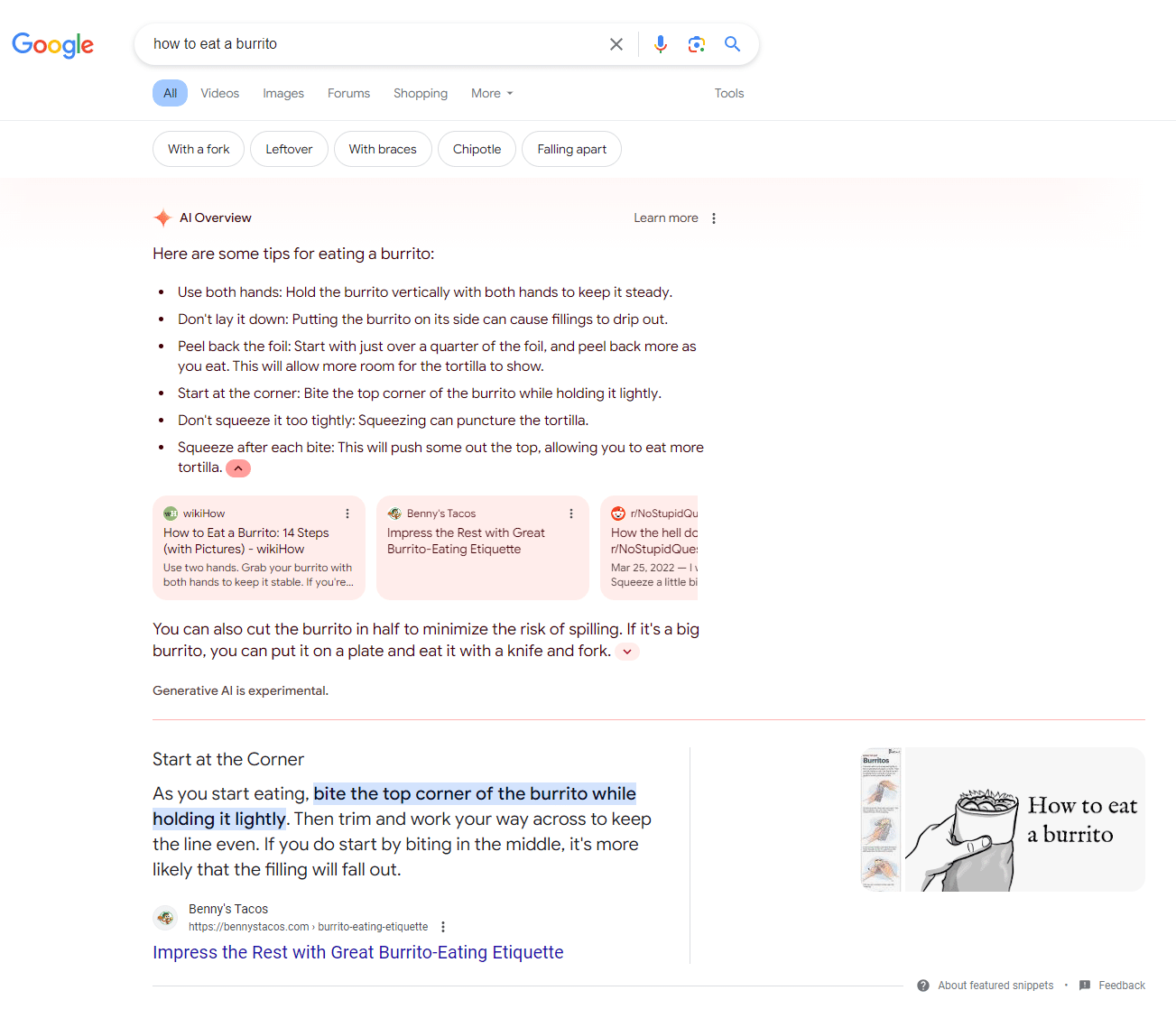
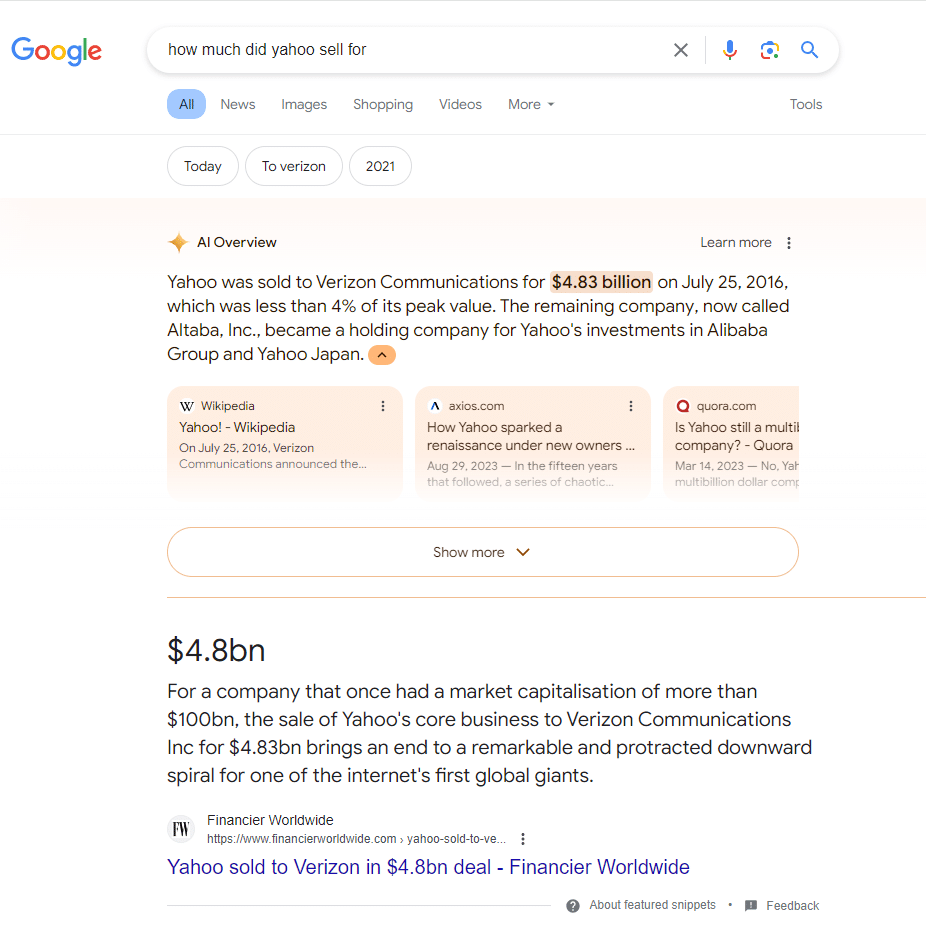
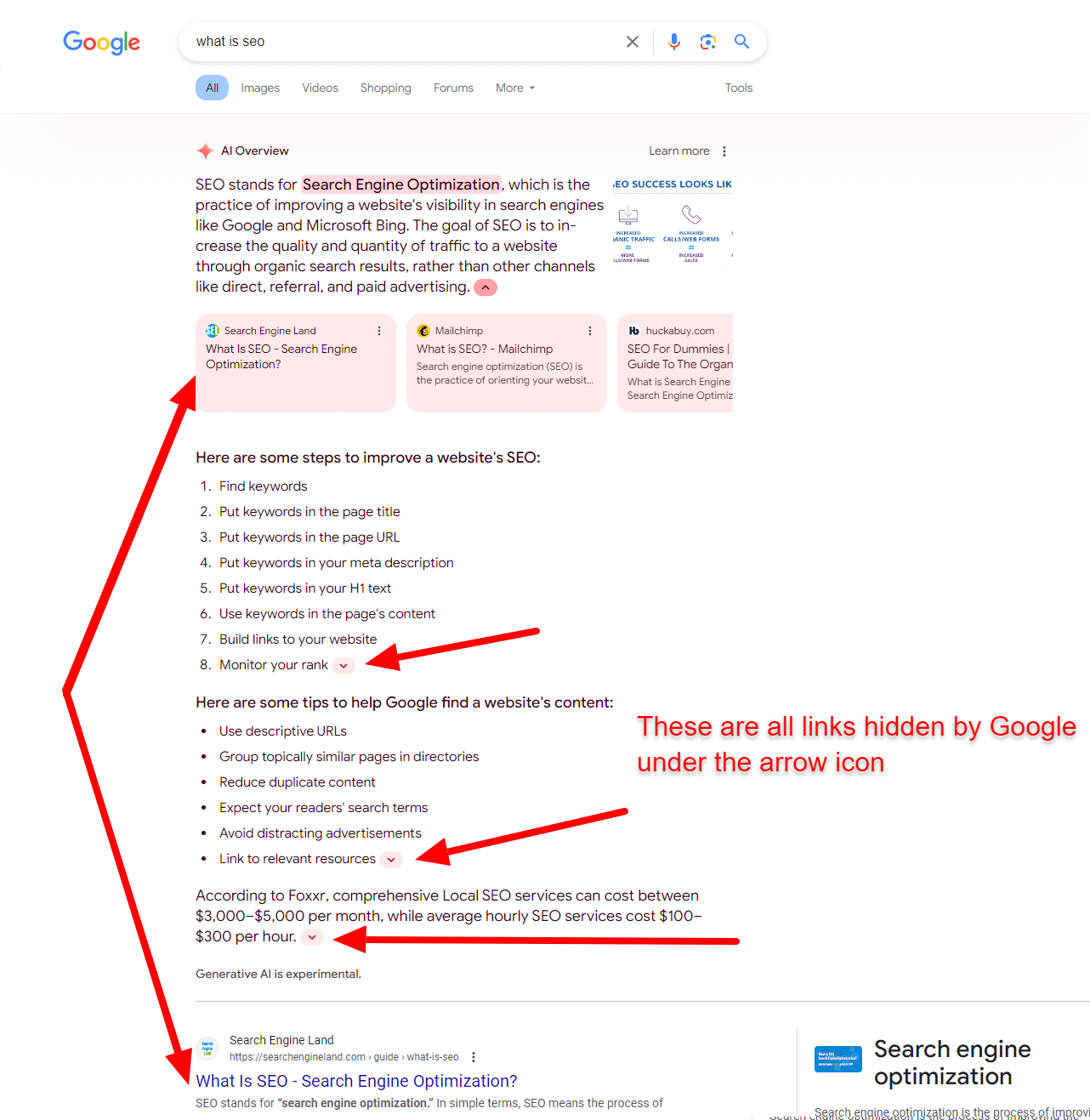
Is it Possible to Block My Content From Being in AI Overviews?
A big question web publishers have is if there’s any real way to keep Google from including their content in the AI Overviews. The real answer is “No”. There is nothing specific to AI Overviews.
However, according to an article by Barry Schwartz at Search Engine Land you can use Google’s “preview” controls to TRY to keep Google from using content in an AI Overview (they treat this as a strong suggestion from what I know). The problem with this approach is that it also removes your eligibility from obtaining a “Featured Snippet” and some AI Overview queries are showing an AI Overview on top of a Featured Snippet which means you’d lose out on the Number 1 ranking and Number 2 ranking if there was only 1 link card in the AI Overview and 1 link (which is typical) in the featured snippet.
How to Control Your Content Appearing in Google’s AI Overviews
As mentioned above NONE of these are specific to the AI Overviews feature and all of these have a negative downside.
1. The Nosnippet Robots Meta Tag
This is a meta robots tag that you can add to your HEAD to keep the all of the content on a page from being used in an AI Snippet. Probably really useful for private content
<meta name="robots" content="nosnippet"> Upside: Strong chance your content is not included in AI Overviews
Downside: Eliminates eligibility for a featured snippet
2. Add a Data-NoSnippet tag to your HTML code
Technically you can keep an entire snippet of text on your page from being included in Google’s Featured Snippets and supposedly AI Overviews as well. However, this only works on Div, Span, and Section tags.
<span data-nosnippet>This shouldn't be shown in an AI Overview</span>
<div data-nosnippet>Also shouldn't be shown in an AI Overview</div> Upside: You can try to remove a specific block of text, passage, or phrase from Google’s AI Overviews.
Downside: Removes any chance at a featured snippet and could decrease traffic as well and is likely only a suggestion.
3. Noindex in Entire Google Search Engine
This is a robots meta tag specifically aimed at the Googlebot useragent that tells it to not index your page in Google.
<meta name="googlebot" content="noindex"> Upside: Almost certain this page will not be indexed by Google.
Downside: Loss of all Google traffic (Search, News, Images, Discover, etc…)
4. X-Robots Header Tag in Apache / NGINX
If you can’t or don’t want to edit your code AND you want to remove an entire document or document type from search engines you could use the X-Robot Noindex Header tag.
File Type Apache:
<Files ~ "\.pdf$">
Header set X-Robots-Tag "noindex, nofollow"
</Files>File Type NGINX:
location ~* \.pdf$ {
add_header X-Robots-Tag "noindex, nofollow";
}Specific File Apache:
# the htaccess file must be placed in the directory of the matched file.
<Files "unicorn.pdf">
Header set X-Robots-Tag "noindex, nofollow"
</Files>Specific File NGINX:
location = /secrets/unicorn.pdf {
add_header X-Robots-Tag "noindex, nofollow";
}Government Scam Warning About SGE / AI Overviews
A warning posted by New Jersey’s Cybersecurity & Communications Integration Cell says Google’s SGE (precursor to AI Overviews) was leading consumers to scam websites to download all kinds of malware.
“However, users are urged to exercise caution with AI-generated responses, as researchers identified that Google’s SGE results may lead to scam sites. The listed websites promoted by SGE used the .online Top-Level Domain (TLD), identical HTML templates, and the same sites to perform redirects indicating that they are likely part of the same search engine optimization (SEO) poisoning campaign. Upon clicking one of the listed websites in the search results, users may undergo a series of redirects until they reach a scam site. These scam sites often host fake CAPTCHAs or fraudulent YouTube sites that push a request to subscribe to browser notifications. Scammers use browser notifications to send unwanted advertisements directly to the operating system’s desktop, even after the website in the browser has been closed. Once subscribed, these spam advertisements redirect users to fake giveaways, unwanted browser extensions, spam subscriptions, and tech support scams.”
h/t to Kevin Indig:
Examples of AI Overviews Being Inaccurate
Here we will catalog examples in the wild of AI Overviews getting things wrong. Send yours to @YoungbloodJoe on X (formerly known as Twitter).
Google’s AI Overviews tell users that smoking is actually good for your health:
AI Overviews are showing comedic / satire content as factual like in this example about running with scissors:
According to this X user AI Overviews is giving really bad cleaning advice:
Google’s AI Overview says it is citing the CDC as a source but the first link card goes to Mayo Clinic, the CDC is the last link card:
Barry Schwartz discovered Google’s AI Overviews giving odd advice about how to recover from a Helpful Content Update (classifier) demotion. The advice includes removing ads and writing with first person pronouns.
Google’s AI Overviews tells users PBNs work for SEO when in reality Google penalizes sites that use PBNs (when they find them). The snippet does clarify this but it highlights the first part of the answer which is obviously misleading.
Google’s AI Overviews recommend using glue to help cheese stick to pizza and appears to have gotten this insight from a singular Reddit post dated 11-years ago by a user named “fucksmith”
Ed Zitron found this one that claims no African nations have a name that starts with a “K” but Kenya sounds close
This AI Overview recommends an adult sexual act for its health benefits and the information appears to cite a satire/comedy website
Google’s AI Overviews recommend to users to cook chicken to an unsafe temperature
Google AI Overview told Business Consultant John D Cook to use gasoline as a sauce to cook a spicy spaghetti
AI Overviews are recommending people marry for money and not for love
An AI Overview told this podcast host that a dog has played in the NBA before
Here Google’s AI Overview tells a user to leave their dog in a hot car
AI Overview tells noted app tear down investigator Jane Wong that everything on the internet is real
Google’s AI Overviews told this woman to smoke while pregnant
Uncertain if this is inaccurate or not, but it’s absolutely not brand safe for Google:
Examples of AI Overviews Plagiarising or Completely Duplicating Existing Works
Here we will catalog examples in the wild of AI Overviews completly duplicating or plagiarising existing works by almost exactly copying them.
In this example Google’s AI Overview took the existing instructions and broke one of the steps down into 2 steps. Aside from that and using more simplified grammar there are no real differences:
Here Google’s AI Overview completely duplicates a Featured Snippet. Text in Featured Snippets is most commonly taken directly from a website. The content in question was indeed stolen directly from DigitalA11y.com
Lily Ray found this one that appears to have copied content directly from a blogger’s site OR is Google’s AI system claiming it has kids:
AI Organized Search Pages
Google’s launch of AI directly in the SERPs is not stopping at taking content from the web and generating a long snippet of text or “Overview” for a user, but will also include the AI organizing the SERPs layout for you. Which honestly looks like a big mess to me.
Google’s example query for this in their blog post was “anniversary celebration places in dallas” which when searched for would trigger Google’s AI to generate a SERP just for that query with different sections all with headings.
It shows in order: A Google Business Profile sponsored ad, a section titled “Anniversary-worthy Restaurants” that appears powered by Google Maps data, a section titled “Celebratory Dallas Restaurants” that shows nothing but links to Reddit threads, a section titled “Live Music and Intimate Settings that uses GBP/Google Maps data and shows business listings, a People Also Ask section that includes unrelated questions like “Where do celebrties eat in Dallas?”, a section titled “Romantic Steakhouses” which shows a lot of video thumbnails from TikTok, a section titled “Critics Picks for Special Occasions” which shows 4 links to web articles by publishers, a section called “Historic Charm and Elegance” which again uses GBP / Google Maps data to display business listings, a section titled “Dishes popular for anniversaries” which uses Google Maps data to show images of dishes at local restaurants, a section titled “Unique Anniversary Dinners” which again is a list of links to web content by publishers again only showing 4 links, and last a section titled “Rooftop Patios for Dates” which appears to use social data from Instagram and TikTok videos.
That is 11 sections and only roughly 8 links all of which appear no higher than middle of the SERPs page taking the user showing the demo 5 swipes on the mobile device to get to them.. For the most part Google’s AI Organized SERP leverages Google-only data and in this example relies heavily on Google Maps listings, reviews, and photos. Outside of Google-owned data the AI SERPs tried to push users to only 3 other platforms: Reddit, Instagram, and TikTok. I am extremely shocked there wasn’t a huge YouTube video section in this demo and my guess is that was on purpose that we’ll most likely see YouTube content highly in these randomly generated SERPs.
It would seem AI really like social media platforms, but mostly Reddit as TikTok and IG content were buried on each page.
REMINDER: You can remove Reddit from Google SERPs by installing our Ultimasaurus extension for Chrome
In her blog post announcing the AI armageddon of search results Liz Reid said that the AI Organized SERPs would soon roll out in the US for English searches starting out with queries about dining and recipes then followed by queries about movies, music, books, hotels, and shopping. She actually says “and more” which is a little scary considering how these SERPs absolutely crush organic open web based content and appear to prefer either Google Maps or social media platforms instead.

Impact of AI Organized Search Pages
The good news is that if you’re a social media platform owner / CEO like Mark Zuckerberg, Steve Huffman, or Elon Musk you appear to have a really good chance of content from your site appearing in here. If you’re a social media “influencer” there’s also a good chance you can optimize content to show in here as well, based on the demo. If you’re a local business this is the best news because Google is using a lot of the data they have from your Google Business Profile to recommend local businesess throughout this new SERP type. It also looks like there might be ways you can optimize for higher rankings in an AI Organzied SERP if you determine it would be valuable.
The bad news is for publishers like local news, culture, etc…. Google appears to be utterly crushing you in this new SERP type you barely get any visiblity and when you do it is extremely far down the page.
This new SERP type appears to Positively Impact:
- Local Businesses
- Social Media Platforms
- Social Media Influencers
And Negatively Impacts:
- Large Publishers
- Independent Publishers
It seems abundantly clear that Google wants to be the publisher now.
What Happens if SEO Really Dies This Time?
Over the past decade preparing for this eventuallity I’ve had a lot of talks with business owners, bosses, and colleagues about what the implications of this would be for websites and more specifically those who rely on SEO. As we’ve seen already in the publishing world where many independent sites got almost completely eradicated during Google’s March 2024 Updates the reality is much the same for the rest of us. If AI Overviews continues to expand and if Google continues to scrape content from the web to feed into their LLM system to give answers directly to users and no links or downstream options, the internet itself dies and becomes merely an echo of Google talking to itself (you could argue today it is frequently Google talking to OpenAI).
Will the web then die? Will we all just log off unless we need something or even then stay offline and go back to brick and mortar most of the time?
You could debate the merits of either side or even that we’ll love what Google does with taking over the entire web and not miss things like 10,000 word articles before a recipe or spam all over Google Maps or people climbing up into your DMs to sell you something you don’t want on LinkedIn.
If SEO traffic even takes a minor hit we will see top heavy sites get into some rough situations. Publishers especially the hyper-local variety, are obvious victims but you could also see travel search sites and blogs getting wiped out completely by this. What was once one of the most lucrative verticals on the web could come crashing down. Real Estate VOWs might also be next since Google can freely crawl and ingest data from MLSes to add to their AI systems. Virtually anything that is a middleman style platform like Amazon and Upwork might also find themselves on the wrong side of things, if AI gets good enough freelancers should be able to get found and gain new clients without giving away a big cut of their revenue. Small ecommerce shops might be able to sell more without the system giving Amazon higher placement.
My belief is that Google’s fate is tied to the fate of the Open Web. If the open web dies then Google dies and probably also OpenAI and a lot of stuff from Microsoft.
As long as Google and other discovery engines live I believe SEO will live, but what we do and how engines interact with us could fundamentally change.
We may no longer be optimizing for ranking positions and clicks, but predicted ranking position (PRP i.e. who appears first and gets the click / open) and specific Tasks.
How to Move Into A Future Without Google
If Google really is signaling the pending death of the Open Web and the role websites / publishers play on the web then how do you move forward? Is that even possible?
Our clients have gotten this information for the past 7-years but today I am including it in this article to help anyone who happens across this plan for the future ahead.
The only way to build your business moving forward or save it is Innovation and Marketing Diversification.
In my opinion every business owner should be doing 2 things right now:
1. Trying to build the next level of their industry.
2. Testing at least one new marketing channel every 6-months.
1. Building the Next Level of Your Industry
I refer to this as “Building a Batman”. The perfect embodiment of your profession. Batman started life as a private detective with a penchant for wearing a cape and cowl and tracking down the worst criminals along with records of their misdeeds during a period of time when this was a popular story trope. Over the decades he morphed into something entirely different, a hyper-intelligent human with near-superhuman abilities for martial arts, deductive reasoning, and various engineering pursuits including computer engineering and mechanical engineering. The Pinkerton Detective Agency was founded in 1850 and by 1861 had built a reputation of being able to do things normal police couldn’t such as foiling an assasination plot. Detectives would become popular story fodder and by 1892 one of the most legendary detective stories ever would be written – Sherlock Holmes by Sir Arthur Conan Doyle. The creator of the Batman would use the growing popularity of detectives and inspiration from Sherlock Holmes then combine it with a more modern story at the time of a masked hero named Zorro and use traits inspired by Leonardo da Vinci’s Batwinged flying machine (Batman’s cape often still appears similar). The creation that would come out of this amalgam would become one the most famous examples of a ‘detective’ in the world for nearly 100 years. Batman though wasn’t even the first comicbook detective or even the first one under the Detective Comics / DC Comics label. That distinction appears to go to Cyril ‘Speed’ Saunders. Even though Batman was not their first detective he was created in a such a way that his character would always be just slightly ahead of current human innovation and invention. Over the years writers would conjure images of him using his money and either his own capabilites or those of others to create new inventions for the sake of his detective work which also becomes harder over time as Batman goes from battling run-of-the-mill criminal scum to governments and intergalactic villains.
The exerceise is simple in statement, but hard in practice. Try to imagine where your industry is in 5 years, 10 years, or 20 years. Then ask what tools, resources, and inventions do not exist to get you there. Are there Blue LED problems in the way? If so, dedicate some time to solving them. Are there consumer adoption problems? If so, consider marketing strategies and tactics to navigate them. Are there infrastrucutre problems in your organization? If so, seek to eliminate them.
You have to work on this at least 20% of your total work time or you will not be able to beat others trying to reach the same point.
2. Testing New Marketing Channels
Every 6-months at least you should be testing a new marketing channel. It does not have to be big, it can be really small like a digital billboard or creating an ebook or developing a subreddit. Or, it can be bigger like developing a podcast, making a series of YouTube videos or TikTioks, or running a Pinterest Ads campaign. Give yourself a few months to fail in this pursuit and see if you can’t develop which ever channel you’ve chosen into a valuable marketing channel. The state of the web today makes this increasingly difficult, for example Meta owned properties don’t really want you to build an audience and then reach them with sales messaging very easily. You might be able to get a meme to go viral today even with a small following but you likely couldn’t get this done with a sales post – even in the comments. The walled gardens know they share a massive volume of power over the web today and like the Titans before the Greek Gods came along there appears to be no one to challenge them. This will make diversifying your marketing channels more challenging but trust me they are out there.
A solid example is a few clients of ours are killing it currently with large public Facebook groups. They spent years building these groups and then suddenly Facebook gave public Groups elevated reach. A few staffers to weed out the spammers and the junk, and to post engaging content for discussion and then a social team of marketers to swoop in and post the offer from time to time to take advantage of all of the reach and activity. Another example is a client of ours using Substack to send special offers to a “Club” of their biggest fans without needing pricey software to manage this then when the fans come to purchase they are given other offers or suggested products.
Get Updates on SEO and Marketing

